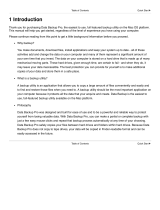
12 FileMaker Server Administrator’s Guide
1 Disconnect a selected client from all hosted databases.
1 Pause or resume hosted databases.
1 Create scheduled tasks to back up hosted databases.
1 View system events and event logs.
1 Start or stop FileMaker Server.
Using FileMaker Server in your network
FileMaker Server works with the following networking technologies:
1 Multiple interface cards: FileMaker Server works with your
network operating system’s ability to utilize multiple network
interface cards (NICs). You can use multiple NICs and IP address
aliases to provide your clients better access to hosted databases.
1 LDAP: You can use a LDAP (Lightweight Directory Access
Protocol) directory service to centrally manage your hosted databases
by registering FileMaker
Server with your directory service.
1 Domain controllers: You can use a domain controller to centrally
manage group accounts that determine client access privileges to
hosted databases.
1 Encryption: FileMaker Server can be configured for encrypting
client data for secure data transfers between the client and hosted
databases. FileMaker
Server uses the Secure Sockets Layer (SSL) of
your network protocol to encrypt and decrypt the data.
New features
In addition to providing reliability and performance improvements,
FileMaker
Server 8 supports both FileMaker 7 and FileMaker 8
clients.
Note FileMaker Server 8 is required for full support of all new
FileMaker Pro 8 features, including complex finds and new
calculation functions.
For information on this feature See
Migration tools to help you upgrade
from FileMaker Server 7 to FileMaker
Server 8
Chapter 2, “Migrating FileMaker
Server from the previous version”
The Mac OS event log fields are now
tab-delimited, and there are two new
fields: event ID and level of severity
(Error, Warning, or Information)
“Logging FileMaker Server events”
on page 38
As FileMaker Server opens files that
were not closed properly or have not
been opened in a FileMaker 8 product,
FileMaker Server performs a
consistency check on each file and logs
the result of the check in the event log
“Step 4. Verify databases are
available to FileMaker clients” on
page 28
The sample database
(FMServer_Sample.fp7) has extended
privileges enabled for use with Instant
Web Publishing and ODBC/JDBC
“Verifying your installation” on
page 22
Improved functionality in the Client
Connections assistant for configuring
FileMaker Server Advanced
FileMaker Server Advanced Custom
Web Publishing Guide
Improved web publishing support in
FileMaker Server Advanced
FileMaker Server Advanced Custom
Web Publishing Guide
Improved ODBC and JDBC applications
support in FileMaker Server Advanced
FileMaker ODBC and JDBC
Developer’s Guide






















